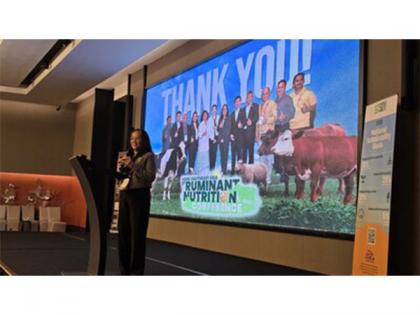Unlocking Opportunity in Southeast Asia's Dairy and Beef Sectors with U.S. Soy
By ANI | Updated: September 4, 2025 11:20 IST2025-09-04T11:15:10+5:302025-09-04T11:20:22+5:30
PRNewswire Bandung [Indonesia], September 4: Southeast Asia's appetite for animal protein is accelerating, with consumption expected to grow more ...

Unlocking Opportunity in Southeast Asia's Dairy and Beef Sectors with U.S. Soy
PRNewswire
Bandung [Indonesia], September 4: Southeast Asia's appetite for animal protein is accelerating, with consumption expected to grow more than 20% by 2031, fueled by rising incomes, urbanization, and population growth[1]. In response, the U.S. Soybean Export Council (USSEC) hosted the inaugural Southeast Asia Ruminant Nutrition Conference in Bandung, Indonesia, from August 27-29, 2025.
The conference gathered participants from the region including producers, nutritionists, researchers, policymakers, and industry leadersto explore how targeted innovation in nutrition, genetics, and farm practices can strengthen local dairy and beef production, enhance sustainability, and reduce import dependency.
"By embracing innovation, collaboration, and data-driven nutrition strategies, Southeast Asia has the potential to address the gap between its rising demand for dairy and beef and local production capacity," said Dr. Basilisa Reas, Technical Director - Animal Utilization, Southeast Asia & Oceania, USSEC. "U.S. Soy offers the consistency and nutritional clarity needed to empower feed producers across the region and unlock sustainable growth."
Participants delved into strategies to elevate regional milk and meat production through improved ruminant nutrition, feed and food safety, genetics, biosecurity, and sustainable systems. A key highlight was the value of U.S. Soy as a consistent, high quality protein source that supports animal performance and feed efficiency.
Over two days of plenary sessions and a day of farm visits, participants explored timely topics such as feed efficiency, sustainability, innovation in genetics, and the role of U.S. Soy in driving improved ruminant performance and profitability.
The discussions highlighted both the sector's growth potential and ongoing challenges. Alltech's 2025 Agri-Food Outlook reported that global dairy feed production rose by 3.2 percent in 2024[2], with overall feed production growing nearly 4 percent annually over the past decade. In Southeast Asia, demand for dairy, beef, and small ruminant products is rising sharply. At the same time, the industry must overcome persistent hurdles: high feed costs, climate pressures, animal health risks, productivity gaps, and the limited resources and market access of smallholder farmers.
U.S. Soy's Nutritional and Sustainability Advantage
U.S. Soy stands out for its exceptional nutritional profile, offering highly digestible amino acids, consistent nutrient content, and strong energy values that support optimal performance in ruminant diets. Its intrinsic value is reinforced by sustainabilityU.S. Soy is responsibly grown under the U.S. Soy Sustainability Assurance Protocol (SSAP), delivering traceability and environmental stewardship that help reduce greenhouse gas emissions and optimize resource use[3]. These combined benefits make U.S. Soy a smart choice for feed manufacturers and producers committed to sustainable growth.
Advancing Ruminant Nutrition with U.S. Soy
Dr. Thomas D'Alfonso, Focus Area Director - Animal Protein at USSEC, presented on the quality advantage of U.S. Soy in ruminant operations. He noted that U.S. Soy offers consistently higher nutrient composition and five times less heat and total damage compared to other origins[4], due to sustainable farming practices and efficient post-harvest handling. Compared with soy from other origins, which often suffer from heat damage and long transport times, U.S. Soy delivers higher digestibility[5], improved energy values[6], and fermentable fiber that supports animal health and nutrient absorptionresulting in better animal performance and profitability.
"Southeast Asia's growing preference for U.S. Soy reflects the region's need for high-quality, sustainable, and efficient feed solutions," said Timothy Loh, USSEC's Regional Director for Southeast Asia & Oceania. "By consistently delivering nutritional and economic advantages, U.S. Soy strengthens feed producers' competitiveness in a dynamic global marketplace."
The conference concluded with visits to a dairy farm as well as a goat and sheep farm, where participants saw innovative practices in nutrition, sustainability, and production efficiency firsthand. These visits complemented the plenary sessions by translating technical discussions into practical, on-the-ground applications and highlighting science-driven solutions shaping modern livestock systems.
A Platform for Regional Collaboration
The Ruminant Nutrition Conference reflects USSEC's commitment to partnering with local industries and governments to advance technical knowledge, promote responsible sourcing, and deliver solutions that drive measurable impact. As Southeast Asia continues to prioritize local livestock production to meet consumer demand, forums like this serve as important platforms for building relationships, sharing expertise, and unlocking shared growth.
[1] OECD-FAO Agricultural Outlook 2022-2031.
[2] https://www.alltech.com/press-release/2025-alltech-agri-food-outlook-shares-global-feed-production-survey-data
[3] These goals were adopted by key U.S. Soy organizations in December 2024 and are based on Field to Market 2020 benchmark.
[4] Huazhen Liu, Mohammad Gishini, Micah Pope, et al. Review of the Quality of Whole Soybeans, Soybean Meal and Oil Shipments. Authorea, September 27, 2022.
[5] American Soybean Association. (2018). The nutritional value of U.S. soybean meal.
[6] Ravindran, V., Abdollahi, M. R., & Bootwalla, S. M. (2014). Nutrient analysis, metabolizable energy, and digestible amino acids of soybean meals of different origins for broilers. Poultry Science, 93(10), 2567-2577. https://doi.org/10.3382/ps.2014-04068.
About the U.S. Soybean Export Council (USSEC):
The U.S. Soybean Export Council (USSEC) focuses on differentiating, elevating preference, and attaining market access for the use of U.S. Soy for human consumption, aquaculture, and livestock feed in 93 countries internationally. USSEC members represent the soy supply chain including U.S. Soy farmers, processors, commodity shippers, merchandisers, allied agribusinesses, and agricultural organizations. USSEC is funded by the soy checkoff, USDA Foreign Agricultural Service matching funds, and industry. Visit ussec.org for the latest information and news about USSEC and U.S. Soy internationally.
(ADVERTORIAL DISCLAIMER: The above press release has been provided by PRNewswire.will not be responsible in any way for the content of the same)
Disclaimer: This post has been auto-published from an agency feed without any modifications to the text and has not been reviewed by an editor
Open in app